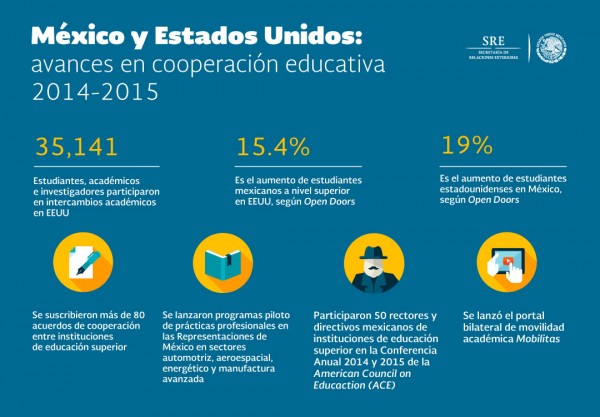
The United States and Mexico are political allies and neighbors with intertwined economies. They both need and at times compete for talent, capital and investments in new technologies. In 2013, the Obama and Peña Nieto administrations launched the High Level Economic Dialogue, a cabinet-level vehicle for deeper engagement on economic issues, and the Bilateral Forum on Higher Education, Innovation and Research, a parallel effort to increase academic and scholarly exchanges between the United States and Mexico. Part of this effort involves cooperation with non-governmental actors to encourage meaningful exchanges among students, faculty and staff from U.S. and Mexican educational institutions at all levels of higher education.
Academic exchanges between countries are critical for robust collaborations in education, research and technological and economic innovation. Regular exchanges and movement of faculty and students back and forth promotes cultural understanding and deeper understandings of each country’s educational and research practices and technologies. Researchers learn about the lines of inquiry that drive innovation in both countries. Over the long term, transnational social and academic networks are strengthened – as has happened before through academic exchanges such as those orchestrated between the United States and Russia and the United States and China.
What are the key challenges and opportunities for leaders trying to strengthen academic ties between the United States and Mexico? Some answers can be found in institutional surveys conducted at Rice University in 2013 and 2014. The results show that, so far, transnational exchanges are hampered by limited communication, inadequate funding, and perceptions of insecurity in Mexico. But important opportunities remain to make progress in the future. more...

 Research to Improve Policy: The Scholars Strategy Network seeks to improve public policy and strengthen democracy by organizing scholars working in America's colleges and universities. SSN's founding director is Theda Skocpol, Victor S. Thomas Professor of Government and Sociology at Harvard University.
Research to Improve Policy: The Scholars Strategy Network seeks to improve public policy and strengthen democracy by organizing scholars working in America's colleges and universities. SSN's founding director is Theda Skocpol, Victor S. Thomas Professor of Government and Sociology at Harvard University.